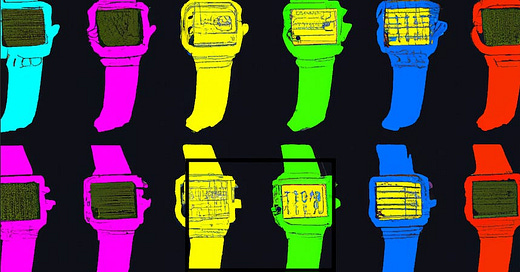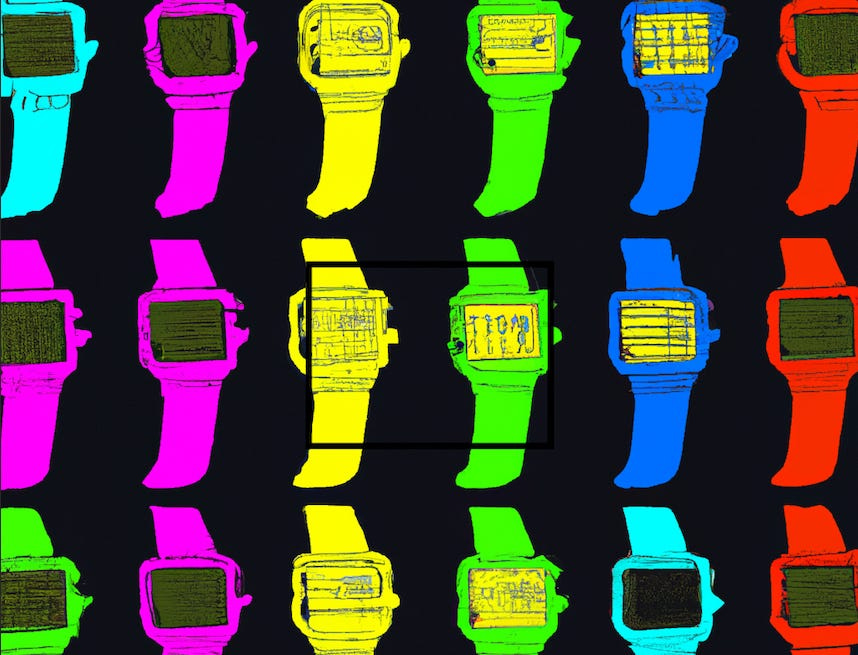Your activity band is wrong. But some are more wrong than others.
Why this matters: Moving enough each day is critical to health and longevity. Here’s how to counter bad data so you’re active enough.
Quick housekeeping
Ask and you shall receive: The 2% gear store is live. We’re selling the 2% hat, the best water bottle I’ve ever used (stamped with a 2% logo), and more.
Here’s what’s coming up for the rest of this week:
Wednesday, we’ll go deeper into activity trackers. We’ll examine whether you can trust their calorie counts and other more in-depth measurements, like heart rates and HRV. I’ll tell you the band I’m currently using and why.
Friday, is our monthly Q&A. A group of Founding Members recently submitted some killer questions. I’ll pick one or two of those and answer them.
2% is Member supported. Have fun, don’t die, be a Member.
One in five Americans wear an activity tracker, and the industry is projected to grow by about 67% in the next five years.
That’s probably a good thing. Research from Australia shows that people who wear activity trackers take about 2,000 more steps a day. Those extra steps are enough to significantly reduce the average person’s risk of various diseases. (Here’s the science on health and step counts.)
Of course, there’s a bit of a chicken and egg problem:
Do activity trackers cause people to be more active, or do people who are already active wear activity trackers?
It’s probably a combination of the two.
Common sense dictates that active people will be more likely to buy products designed and marketed to active people.
But activity trackers also make you aware of your activity level, and people don’t change behaviors they’re unaware of. An extensive review indeed found that people moved more after buying a tracker.
Are trackers accurate?
In short
Activity bands overcount steps by an average of 25%.
The details
Scientists have been studying the accuracy of activity trackers for decades.
In 2020, a team of researchers in Canada culled all the data from 158 studies on the topic. Their research included nine different brands like FitBit, Garmin, Apple, and more.
Their conclusion: “No specific brand stood out as the ‘gold standard’ in fitness wearables.” Every brand had flaws in its data. Many of the studies their review pulled from used fancy language like “low validity” to describe a rather basic phenomenon: activity trackers are all some degree of wrong.
But the review included many old studies. Which means the data came from old technology. As we all know, technology advances quickly.
To see if the technology has improved and whether we can rely on trackers we can buy right now, the New York Times recently tested 34 new trackers.
It might sound unscientific for a journalistic outlet to do this testing, but the setup was as it would be in a university research setting. The Times also recruited a team of scientists to help.
The Times was most interested in knowing how accurate the devices are at tracking steps across a day.
This is important. Many devices do decently well tracking brisk walks. Like, if you took 1,000 steps on a treadmill going a few miles an hour, most trackers would be pretty accurate. The average tracker only undercounts steps during a brisk walk by about 2 percent.
But in daily life, all sorts of arm movements that have nothing to do with walking can easily get counted as steps. Folding laundry. Rummaging through the fridge. Brushing your teeth. Aggressively swiping through Twitter. Research also shows that trackers are pretty bad at counting slower walks and movements.
So the Times tested those 34 trackers against a pedometer. Pedometers are significantly more accurate at counting steps because they attach to your hip and not your arm. They’re frequently used in studies as the “gold standard” for measuring steps.
The findings: All the activity bands were off.
Three of the 34 bands underestimated daily step counts. The rest—31—overestimated. And not by, like, a couple of hundred steps.
On average, the bands overcounted steps by 25 percent. So, for example, if you took 10,000 steps in a day, the average band in the study would tell you you’d taken 12,500.
But one band overestimated by 245 percent. Imagine that … if you walked 10,000 steps, it would lead you to believe you’d hit 24,500 for the day.
Here is how much a few popular brands overestimated step counts:
Apple: 18%
Samsung: 13%
FitBit: 25%
Garmin: 18%
Polar: 31%
Oura Ring: 17%*
(*The Times didn’t test the Oura Ring. This data is pulled from this study.)
Variations within brands
You might see the data and think, “Don’t buy FitBit or Polar, do buy Samsung.”
But, unfortunately, it’s more complicated than that. For example, one FitBit underestimated step counts by 6% (which is ideal), while another overestimated by 90%. One Apple watch model overestimated by 16%, while another was 21% over. Garmins ranged from overcounting by 6% to 55%.
The winners from a few brands:
Fitbit Inspire and Charge 5 were off by only 5 to 6 percent.
Garmin Vivoactive 4s overcounted by just 7 percent.
Why steps matter
In short
Some fitness trackers no longer track steps. This comes with downsides.
The details
Some activity tracking companies, like WHOOP, don’t count steps. Instead, they focus on “strain score.”
To calculate strain score, WHOOP pulls from data like your heart rate and what they call muscular load, which measures movement, and like, steps is calculated using gyroscopes. All those measurements go through a complicated algorithm to give you a daily strain score.
I think activity trackers should have step counts. Step counts are one of the most researched health metrics on the planet.
As we’ll learn on Wednesday, if you think that the step tracking data you’ve just seen is questionable, wait until you see what happens when a brand takes more complex measures like heart rate, pairs it with gyroscopic measurements, then tries to run it all through a complex algorithm they invented in-house to give you one grand metric of daily work.
“Strain score,” too, can incentivize thresher workouts at the expense of less intense training, which we know is part of a healthy workout approach. It can also disincentivize generally moving more throughout the day. In other words, being a 2-Percenter gets downvoted.
Going hard occasionally is essential (see Burn the Ships). But research suggests that total work across a day is more important than work intensity. Translation: You’re likely better off getting 8,000 meandering steps than you are 4,000 steps from a run.
Steps are the most useful metric to gauge your non-exercise activity—all the movement you do that isn’t exercise.
Non-exercise activity is just as, if not more important than your workouts. Here’s why:
When people exercise, they then tend to move less throughout the day. The same thing happens when we lose weight.
Your body doesn’t want you to burn extra energy or lose weight. It’s an ancient survival mechanism that kept us alive when food was harder to come by and losing weight didn’t make sense.
Your body compensates for exercise or weight loss by reducing your activity level in daily life. You’ll fidget less. You’ll be less likely to get up and walk around the house or go for a spontaneous walk.
Critically, this all happens subconsciously. We don’t realize we’re moving any less, but we are.
Getting enough steps is a straightforward way to offset the reduction in daily movement from exercise or weight loss. Steps tell you you’re getting a minimum level of daily activity. Strain counts do account for this, kind of, but the algorithm can muddy the waters.
An even bigger problem with abstract numbers
Unlike step counts, strain scores are unpredictable and abstract.
And abstract, unpredictable figures have some other big downsides. I have a chapter about this in my next book, Scarcity Brain (which you can pre-order now).
And it doesn’t just apply to activity tracker strain scores—the problem is embedded in the apps and institutions that most influence our daily lives, public policy, and more.
This is big, important stuff that few people are talking about. When you see it, you can’t unsee it.
How to use this information
It’s not the end of the world if your activity tracker is wrong. Here’s how you can counter inaccurate data:
1. Take 25 percent off your number
In general, that’ll give you a more accurate reading. So, for example, if your tracker says you took 10,000 steps, assume you actually took 7,500.
2. Wear the tracker on your non-dominant arm
This cuts down on miscounts because your dominant arm moves more in daily life. The trick won’t make or break your data. Research shows that for many bands, the difference in daily step counts between wearing it on your dominant or non-dominant arm isn’t significant. But for some the difference can be anywhere from two to four percent.
3. Notice trends
If you just want to be more active, wrong data may not really matter. Let’s say you went from taking an incorrect 6,000 steps a day to an incorrect 12,000 steps. Well, you still moved more, no matter what the real number of steps you took is. So just try to hit some large number every day and you’ll be fine.
4. Wear a pedometer for more accurate counts
This pedometer costs $20.
If you want to do your own study to see how off your tracker is—which is nerdy but fun!—do this:
Wear the pedometer and your tracker for a week.
Average out the percent difference in your step counts between days.
Average those averages across a week.
Now that you have your activity band’s average error percentage, simply take that percentage off of your band’s daily step counts from then on.
Have fun, don’t die.
-Michael
Sponsored by GORUCK
When I decided to accept sponsorships for this newsletter, GORUCK was a natural fit. Not only is the company's story included in The Comfort Crisis, but I've been using GORUCK's gear since the brand was founded. Seriously. They've been around ~12 years and I still regularly use a pack of theirs that is 11 years old. Their gear is made in the USA by former Special Forces soldiers. They make my favorite rucking setup: A Rucker 4.0 and Ruck Plate. Use discount code EASTER for 10% off anything from GORUCK.
Sponsored by Momentous
Momentous made me feel good about supplements again. Over 150 professional and collegiate sports teams and the US Military trust their products, thanks to the company’s rigorous science and testing. I don’t have the time or desire to cook perfectly balanced meals that give me all the necessary nutrients and protein I need (let’s face it, few of us do!). So I use their collagen in the morning; Recovery protein during hard workouts; essential multivitamin to cover my bases; creatine because it’s associated with all sorts of great things; and Fuel on my longest endurance workouts on 100+ degree days here in the desert (because Rule 2: Don’t die). And I also love (love!) that Momentous is researching and developing women-specific performance supplements. Use discount code EASTER for 15% off.





I am a long time Whoop wearer and using it helps me dial in habits that are beneficial using month long self-experiments, but I ignore the Strain recommendations. . My performance assessment always says "Strain was overreaching and supported with optimal sleep." I "overreach" daily according to Whoop but only actually overreach once or twice a week.
I know there is a big debate with Whoop adding a step count, I hope they don't because it's not data I need at all but after reading this I can see why it's probably going to happen eventually.
Really made me think about my tracker today this did. Great piece